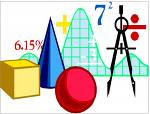A quantity with an exponent has three components--the base, the
exponent, and the coefficient.
Example:In the quantity 3x^5, the coefficient is 3, the base is x, and the exponent is 5.
**note x^3 is x raised to power 3
Quotient Law :a ^m / a ^n = a^ (m – n) where m, n are real terms and a not equal to 0
In division, If base of two terms is same then subtract the exponent of denominator from the exponent of numerator
*This rule is applicable only when base is same8
Example:simplify
7 ^6 ÷ 7^ 4
7^ (6-4) (here Base is same,using quotient rule)
7 ^2
Practice:simplify
5 ^8 / 5 ^5
7^6 ÷ 7^5
2^5 ÷ 2^9
Answers:
5^3
7^1
2^(-4)
Example:simplify
8^6 ÷ 8^ -4
8^ (6-(-4)) (here Base is same,using quotient rule)
8^(6 +4)
8^10
Practice:simplify
3^4 ÷ 3^-5
12^5 ÷ 12^-5
5^7 ÷ 5-3
Answers:
3^9
12^10
5^10
Practice:simplify
x^8 ÷ x^-3
y^5 ÷ y^3
p^7 ÷ p^4
Answers:
x^11
y^2
p^3
Wednesday, August 20, 2008
Subscribe to:
Post Comments (Atom)

3 comments:
Thanks so much! Def. needed this breakdown for my notes. Anyway you could show a breakdown of the steps to solve bigger equations like:
2x^4 OVER (3z^-3)^2 TIMES (3z^7)^2 OVER 2xy^6
what about:
10(p+q)^7 / (2(p+q)^2(p+q)3)???
Post a Comment